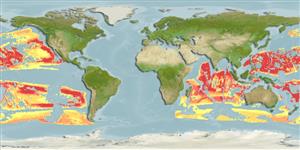>
Ophidiiformes (Cusk eels) >
Ophidiidae (Cusk-eels) > Neobythitinae
Etymology: Typhlonus: Greek, typhlos = blind + Greek, onos = hake.
More on author: Günther.
Environment: milieu / Zona climática / intervalo de profundidade / distribution range
Ecologia
marinhas batidemersal; intervalo de profundidade 3935 - 5100 m (Ref. 58167). Deep-water
Indian and Pacific.
Tamanho / Peso / Idade
Maturidade: Lm ? range ? - ? cm
Max length : 28.5 cm SL macho/indeterminado; (Ref. 34024)
Descrição suscinta
Chaves de identificação | Morfologia | Morfometria
Raios dorsais (total) : 93 - 104; Raios anais : 71 - 78. Caudal fin rays 8. Bifurcate operculum spine and external thymus present (Ref. 40708).
Rare species (Ref. 34024). Reproductive strategy possibly similar to other members of this family featuring oviparity, with oval pelagic eggs floating in a gelatinous mass (Ref. 205).
Ciclo de vida ou comportamento de acasalamento
Maturidade | Reprodução | Desova | Ovos | Fecundidade | Larvas
Nielsen, J.G., D.M. Cohen, D.F. Markle and C.R. Robins, 1999. Ophidiiform fishes of the world (Order Ophidiiformes). An annotated and illustrated catalogue of pearlfishes, cusk-eels, brotulas and other ophidiiform fishes known to date. FAO Fish. Synop. 125(18):178p. Rome: FAO. (Ref. 34024)
Status na Lista Vermelha da UICN (Ref. 130435: Version 2025-1)
Ameaça para os humanos
Harmless
Uso pelos humanos
Pescarias: sem interesse
Ferramentas
Relatórios especiais
Baixar XML
Fontes da internet
Estimates based on models
Preferred temperature (Ref.
123201): 0.8 - 1.8, mean 1.4 °C (based on 7134 cells).
Índice de diversidade filogenética (Ref.
82804): PD
50 = 1.0000 [Uniqueness, from 0.5 = low to 2.0 = high].
Bayesian length-weight: a=0.00110 (0.00040 - 0.00297), b=3.08 (2.85 - 3.31), in cm total length, based on LWR estimates for this (Sub)family-body shape (Ref.
93245).
Nível Trófico (Ref.
69278): 3.6 ±0.6 se; based on size and trophs of closest relatives
Resiliência (Ref.
120179): médio(a), tempo mínimo de duplicação da população 1,4 - 4,4 anos (Preliminary K or Fecundity.).
Fishing Vulnerability (Ref.
59153): Low vulnerability (25 of 100).
🛈
